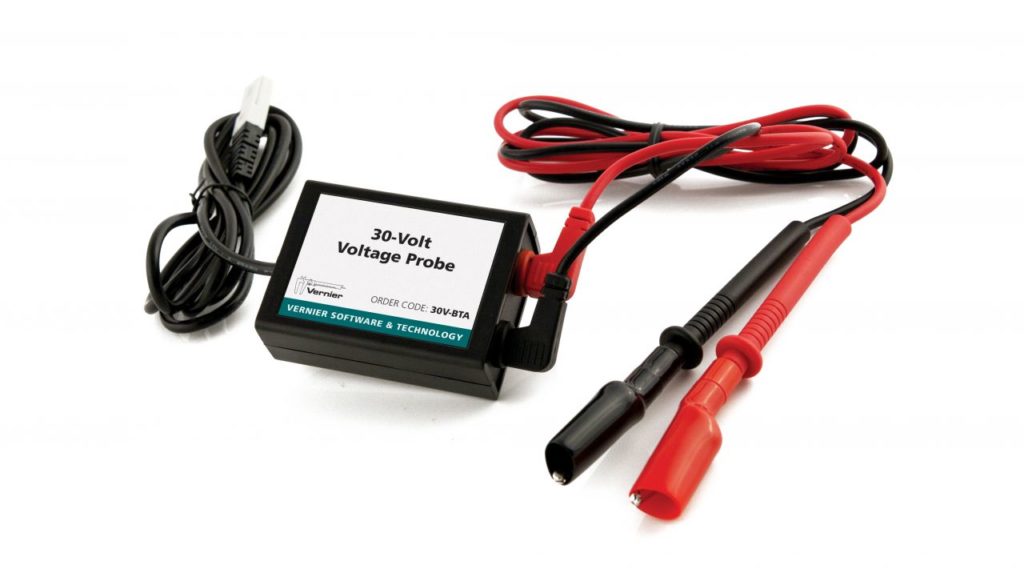30-Volt Voltage Probe User Manual
Order Code: 30V-BTA
The 30-Volt Voltage Probe is used to measure electrical potentials in the range of –30 to +30 Volts. This sensor uses an internal voltage divider connected to the +/-10 volt input of the interface. Use this sensor in experiments that involve voltages larger than 10 Volts, such as when working with large solar panels.
The removable leads on the 30‑Volt Voltage Probe are heavy duty and have shrouded banana plugs to meet European safety standards.
Since this voltage probe covers such a wide voltage range, its resolution is coarser than our Differential Voltage Probe (DVP‑BTA), which we recommend for most experiments.
Note: Vernier products are designed for educational use. Our products are not designed nor are they recommended for any industrial, medical, or commercial process such as life support, patient diagnosis, control of a manufacturing process, or industrial testing of any kind.
Compatible Software
Choose a platform below to see its compatibility requirements.LabQuest
Interface LabQuest App LabQuest 3 Full support LabQuest 2 Full support LabQuest Full support Computers
Software Interface Graphical Analysis Graphical Analysis (Web App) Logger Pro (discontinued) Logger Lite (discontinued) LabQuest Mini Full support Full support Full support Full support LabQuest 3 Full support Full support Full support Incompatible LabQuest 2 Full support Full support Full support Full support LabQuest Stream Full support 1 Full support 1 Partial support 2 Full support 1 Go!Link Full support Full support Full support Full support LabQuest Full support Full support Full support Full support LabPro Incompatible Incompatible Full support Full support Compatibility Notes
Chromebook
Software Interface Graphical Analysis (Web App) LabQuest Mini Full support LabQuest 3 Full support LabQuest 2 Full support LabQuest Stream Full support 1 Go!Link Full support LabQuest Full support Compatibility Notes
iOS
Software Interface Graphical Analysis Graphical Analysis GW LabQuest Stream Full support Full support LabQuest 3 Full support 1 Full support 1 LabQuest 2 Full support 1 Full support 1 Compatibility Notes
Android
Software Interface Graphical Analysis Graphical Analysis GW LabQuest Stream Full support Full support LabQuest 3 Full support 1 Full support 1 LabQuest 2 Full support 1 Full support 1 Compatibility Notes
Arduino
Software Interface Arduino Vernier Arduino® Interface Shield Full support LabVIEW
Software Interface NI LabVIEW SensorDAQ Full support Go!Link Full support LabQuest Mini Full support LabQuest Stream Full support LabQuest 3 Full support LabQuest 2 Full support LabQuest Full support Texas Instruments
Software Interface EasyData DataMate TI-84 SmartView DataQuest TI-Nspire Software EasyLink Full support 1 Incompatible Full support 2 Full support Full support 2 CBL 2 Full support 3 Full support 3 4 Incompatible Incompatible Incompatible LabPro Full support 3 Full support 3 4 Incompatible Incompatible Incompatible TI-Nspire Lab Cradle Incompatible Incompatible Incompatible Full support Full support Compatibility Notes
Quick Start
- Plug the sensor into the interface (LabQuest 3, LabQuest Mini, etc.).
- Connect the interface to your device.
- If using USB, connect to the USB port on your computer.
- If using Bluetooth® wireless technology, click your interface type and then select your device.
- Prepare for data collection:
- Vernier Graphical Analysis®: Launch the app, if necessary, and click Sensor Data Collection.
- LabQuest® App: Choose New from the File menu.
The software will identify the sensor and load a default data-collection setup. You are now ready to collect data.
Need Additional Information?
Visit the following link:
www.vernier.com/start-lq-sensor
Note: Vernier products are for educational use only.
Safety
This sensor is designed for voltages up to 30 volts. It should never be used for higher voltages. Students need to use caution when performing experiments with electricity. They should use this sensor only under supervision. Students need to exercise extra caution when dealing with higher voltage and currents which can cause serious injury. Students should keep all equipment away from water and other liquids.
Videos
Calibrating the Sensor
You should not have to perform a new calibration when using the 30-Volt Voltage Probe in the classroom. The sensor will normally be automatically recognize and the proper calibration will be loaded. We have set the sensor to match our stored calibration before shipping it. To improve the accuracy, you have a couple of options. (1) Simply use the data-collection software to zero the sensor. (2) Use the software to perform a two point calibration. This method is especially useful if you want to accurately measure voltage over a narrow range.
Specifications
|
30-Volt Voltage Probe range |
±30 V |
|
Resolution |
15 mV |
|
Supply voltage |
5 VDC |
|
Supply current (typical) |
0.2 mA |
|
Input impedance |
30 kΩ |
|
Output voltage range |
±10 V |
|
Calibration |
slope: 3.0 V/V intercept: 0 |
Care and Maintenance
Do not wrap the cable tightly around the sensor for storage. Repeatedly doing so can irreparably damage the wires and is not covered under warranty.
How the Sensor Works
The 30-Volt Voltage Probe uses an internal voltage divider made up of a 10 kΩ resistor in series with a 20 kΩ resistor. The input voltage is applied across this voltage divider and the voltage drop over the 10 kΩ resistor is sent to the +/‑ 10 volt input of the interface. The resulting voltage is then multiplied by 3 for proper calibration.
There are zener diodes between the input and ground lines. These zener diodes will block voltages above 30 volts.
There is a resettable fuse on the ground line of the 30‑Volt Voltage Probe that will open if any significant current is drawn on that line. This could happen, for example if you were using it on a grounded interface, with a grounded power supply, and the ground lead was connected improperly to a voltage above ground potential.
Troubleshooting
For troubleshooting and FAQs, see www.vernier.com/til/2322
Warranty
Warranty information for this product can be found on the Support tab at www.vernier.com/30v-bta/#support
General warranty information can be found at www.vernier.com/warranty
Contact Support
Fill out our online support form or call us toll-free at 1-888-837-6437.

